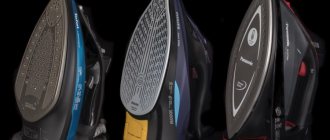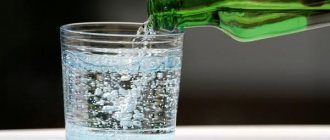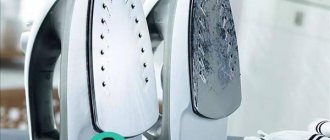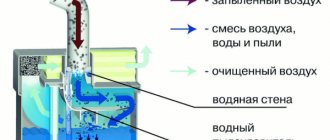How to choose
There are different types of electric irons available in stores today. To avoid getting lost among the counters, take a consultant as your guide. And in order to correctly use the advice of a store specialist in technology, you need to determine in advance for yourself the significant technical characteristics in the selection of an iron.
Price is the most important thing for a family budget. The cost of the iron consists of:
- manufacturer's fame;
- product functionality;
- quality and guarantees;
- store markups.
In this article, we will explore the qualities you should look for so that you can choose a good iron for your home. So let's get started.
View
To choose the right iron, you need to know what type you need. The types of irons are as follows:
- ordinary household iron;
- with the possibility of steaming;
- steam generators with a separately located boiler.
If you need an appliance for business trips, then you can choose a small, modern electric iron, the weight of which will not overload your luggage.
Irons with steamers will cost more, but ironing with their help will be a simple task.
Regular
Irons that do not have any functions other than hot ironing are now practically not produced. This outdated type of device was mass produced 40-50 years ago. It had an iron body, weighed 2 kg and was extremely reliable, like everything Soviet. If you see one in the mezzanine, check: maybe it is still working.
The operating principle of an electric iron is simple: the soleplate heats up and you iron the laundry. If the folds cannot be removed, iron them with a damp cloth or use a spray bottle.
Steam
A high-quality steam iron is the best option for the money. It is equipped with standard functionality for modern irons:
- power adjustment according to fabric type (synthetics, silk, cotton, linen);
- nasal drip spray (not everyone has it);
- steaming mode;
- steam boost function (not provided everywhere);
- overheat protection;
- anti-scale protection (appeared recently, not available in all models even in 2021).
The irons are housed in a plastic case, which reduces their weight. The soles of electric irons are different: from aluminum to ceramics.
With steam generator
A device with a steam generator will cost more on your wallet. These are rather large steam systems designed to facilitate the ironing process. If with a conventional iron you can handle a pile of laundry in an hour, then with a steam system you will spend at most 20 minutes.
In steam generators, the water boiler is located separately from the iron. It holds from 1 to 2.5 liters of water, which makes it possible to iron any amount of clothing. The amount of liquid evaporated affects the saturation of the supplied steam flow: this is the reason that the fabric is smoothed almost instantly.
Types of steam generators:
- horizontal, where the boiler serves as a stand for the iron;
- vertical - are considered professional systems that smooth out hanging things.
Vertical steamers have various attachments for hand irons, but not all have a horizontal steaming function. The iron does not look like an iron; it looks more like the attachment of a washing vacuum cleaner. When speaking below about the properties of irons, we will mean a standard device with a steaming effect or a horizontal steam station.
Iron functions
A modern iron is no longer just a primitive device, it is a concentration of a large set of different technologies that facilitate and speed up the ironing process.
Let's look at the most common functions found in modern electric irons.
Continuous steam function
To make it easier to iron heavy fabrics or simply dry linen with caked folds, water was previously used by splashing onto the fabric.
Nowadays, irons have steam supply functions, both forcibly when you press a button, and constantly. The more holes in the sole, the more steam comes in and the easier it is to iron.
The holes should be located along the entire working surface of the iron; it is also good if there are grooves that promote uniform distribution of steam.
The measuring characteristic of this function is the amount of water in grams converted into steam in 1 minute. Constant steam supply can be from 10 to 150 g/min.
For ordinary, not overdried fabric, an iron with a steam supply of 20-30 g/min is sufficient, but for heavy fabrics it is better to choose an iron with a constant steam supply of 80 g/min.
Pay attention to the water container. It should be transparent or translucent, which will allow you to monitor the level and add water on time.
It is also worth paying attention to the volume of this container; the larger the steam supply, the larger the water tank should be. There are models that hold 150-250 ml.
Steam boost
A steam boost is used when working with particularly difficult fabrics that cannot be ironed using a simple steam supply.
The steam supply speed in irons with a steam boost must be at least 100 g/min.
Vertical steaming
Vertical steaming helps to cope with such things as curtains, outerwear, etc.
The ironing process occurs in a non-contact manner using steam when the items are in a vertical position, for example on a hanger, and not on an ironing table.
Anti-drip system
The anti-drip system prevents water droplets from escaping through the steam holes when ironing at low temperatures, which can lead to stains on the fabric.
Self-cleaning system
The self-cleaning system cleans the iron of scale and is turned on by a special button after heating in steam mode.
If the iron is equipped with this function, then there is no need to fill in special water for irons and purchase cartridges that prevent the formation of scale.
Automatic iron shutdown
Auto shut-off is a very useful feature that prevents the possibility of a fire due to a forgotten iron not turned off.
If the iron is in a vertical position motionless for about 10 minutes (different models vary) or in a horizontal position for 30 seconds, it will automatically turn off.
The main criteria for choosing an iron are listed above, but for greater ease of use, some other features should be taken into account.
Sole
Once you have chosen the type of device, it's time to think about the sole material. This part is in direct contact with clothing. It determines how easy the ironing process will be.
The sole is characterized by several parameters: material, its shape, number and position of holes on the surface. Let's look at each of them separately.
Material
The material from which the soles are made can be:
- metal;
- ceramic.
Metal irons come in aluminum, steel, metal-ceramic, titanium and steel with various coatings. Now you will learn the pros and cons of each sole surface so that you can immediately find the iron option you need in the store.
Ceramics
Advantages of ceramic soles over metal ones.
- Smoothness. Due to its structure, it is not susceptible to scratching, so during ironing it will not catch on the fabric, ensuring easy sliding.
- Fast heating. Ceramics heats up almost instantly and is able to retain heat for a long time. The sole is heated evenly over the entire area.
- Economical. You don't have to wait long for the surface to reach the set temperature, which saves energy.
- Easy cleaning. If melted fabric adheres to the soleplate, it can be easily removed from the appliance. Wait until it cools down and wipe the surface with a damp sponge.
In addition to the advantages, there is also a disadvantage to using ceramics in an iron. It lies in the fact that this material is fragile. If the device is allowed to fall from a height, its sole will crack. You will have to throw away the iron because it cannot be repaired.
Aluminum
Aluminum is a lightweight metal, so irons will weigh little and heat up quickly. You don't have to worry that the device will rust. Thus, the device will perform its functions properly for a long time, and the cost in stores will be low.
The low density of aluminum determines its ductility, which in practice leads to easy scratches and deformations on the sole. The use of irons with aluminum soles leaves a characteristic shine on woolen items. To prevent it, our mothers used damp gauze while ironing. Cleaning the aluminum soleplate is not easy. You may scratch the surface while cleaning. This will lead to clothes getting caught during ironing.
To eliminate this drawback while maintaining its advantages, manufacturers oxidize the outer layer of the sole with an electrolyte solution, making it more resistant to damage.
Stainless steel
The most common sole in modern electric irons is steel. Despite the fact that hardened steel has a significant weight, which increases the weight of the device, the advantages of using the alloy more than offset this disadvantage.
- resistance to deformation;
- durability;
- excellent ironing quality;
- affordable price.
Over time, microscratches begin to appear on the soles, reducing the quality of gliding. To further improve the quality, the developers came up with the idea of using all sorts of additional layers of coatings and coatings:
- sapphire layer – a high-carbon coating, the density approaching sapphire (the stone itself is not in the device);
- Teflon layer – Teflon prevents fabric from sticking and makes sliding extremely easy;
- ceramic layer - allows you to add all the advantages of a ceramic sole, excluding the disadvantages.
The use of additional layers immediately makes the price of the device higher, keep this in mind. Spraying, no matter how good it is, wears off over time.
Teflon
The Teflon coating will allow you to enjoy the ironing process, because your new iron will practically glide on its own. You won't have to clean it, because nothing will burn.
But Teflon is easy to scratch, so you need to avoid places containing buttons, zippers, metals, rhinestones, and hard plastic.
Metal ceramics
Ceramic on a steel base will help the iron slide easily over buttons and snaps, warm up quickly, and make cleaning the surface easier. Just don’t hit the sole on hard things to avoid chipping.
There is another material from which the soles of electric irons are made - titanium. The properties of the metal ensure high quality products:
- strength;
- excellent glide;
- no scratches at all times;
- uniform heating.
A huge minus is its price. The iron will be expensive, but of high quality. Most often, they do not make a completely titanium sole, but apply several layers of it.
When choosing an iron, look in the description on the packaging for characteristic words that will indicate the appropriate sole covering:
- aluminum with electrolyte - Anodilium, Careeza, Eloxal, NanoTech;
- with steel coating – Inox Glisse;
- with ceramics – Ceraslide-Color;
- with platinum – Platinum;
Manufacturers come up with new types of coatings and names for them all the time, so it is not possible to list everything. But you have received a general overview, and now you can navigate the words written on the packaging.
Form
The convenience of ironing depends on the outline of the sole. The standard triangle has changed over time to suit consumer needs. Depending on what you iron the most, choose the type of sole.
- The narrow sole with a pointed tip is suitable for treating areas between buttons, small items, children's items, as well as clothes with darts, folds or frills. The sole can be pointed on both sides.
- The large rounded sole with a blunt nose is ideal for ironing bed linen, curtains and other items that have a large area.
Holes
The more steam holes, the easier the laundry will be ironed - this is an axiom. Pay attention to these points when choosing an iron.
- Holes on the spout allow you to steam hard-to-reach places.
- The grooves and depressions extending from the holes are made so that the escaping steam is concentrated above the fabric and softens it even more. This creates the effect of an “air cushion”, which allows you to avoid pressing the iron against the laundry to smooth it out.
The amount of steam coming out directly depends on the power of the heating element, that is, at what speed the iron is capable of evaporating water.
Steam boost
This is another feature that is found in almost every modern iron. If even at the maximum power of the iron it is not possible to smooth out a complex crease, this function comes to the rescue. It is activated by one single button. You press it, and steam under high pressure comes out of the holes in the sole. As a result, the fold is truly even. Feed speed also plays an important role and influences the efficiency of the function. Maximum efficiency is guaranteed by a speed of 90 to 120 g/min.
Unlike a constant supply of steam, a steam boost cannot be constant. To generate and accumulate hot steam, a “recharge” is required, which lasts about 20 seconds. Models with a steam generator (with a large water tank) can continuously supply steam at high pressure.
Power
It would seem that the more powerful the iron, the better. This happens almost always. Just let's take into account that part of the energy consumption goes to warming up the sole and generating steam.
Think about how much laundry you usually iron. For small amounts of laundry, a standard steam iron with a steam boost and adjustable steam supply is suitable. Normal power for a good iron is 1500-2000 W.
Since the soles are ceramic or aluminum, which do not take much time to heat up, the power will also not be great in these models. This doesn't mean the iron is bad. This means that it has a high energy efficiency class.
Look for energy rating labels on the packaging. The most economical option is A++, then A+, A, B+ and so on. If the device has many additional functions, this will require increased power.
Iron power
An indicator such as power determines how quickly the iron will heat up and the complexity of the fabric it can iron.
Depending on how much time is spent on ironing, the power of the iron is selected. They can also be divided into several types:
- Travel irons. Their power is about 1000 W. It is impossible to smooth heavy materials with such models, but they are convenient for travel due to their small dimensions. They work well with suits, T-shirts or dresses made of light fabric.
- For a small family of one or two people, irons with a power of 1000-1500 W are suitable. They iron almost any fabric, but take a long time to heat up.
- For a family of three to four people, irons with a power of 1500-2000 W are suitable. It heats up quickly and also smooths out even heavily wrinkled laundry, without requiring any effort from the owner.
- For those families where at least two hours a week are allocated for ironing, models with a power of 2000 W or more are suitable.
Video on how to choose an iron:
Functionality
The convenience of using an electric iron depends on the presence of additional functions. It’s better to determine in advance what you need and what doesn’t matter before purchasing.
Steam boost
With constant or adjustable steam supply, the flow power is 50-90 g/min. This is enough to deal with wrinkles without effort. In case linen or cotton laundry is very dry, some models have a steam boost function. When you press the corresponding button, 1.5-2 times more water evaporates to cope with unruly creases.
Sometimes, at the beginning of use, when you press the steam supply, you see how the iron “spits” droplets of liquid. Drop protection combats this.
Anti-drip system
When the iron cools down, condensation accumulates on the walls of the steam apparatus. When turned on again, the condensed vapors exit through the steam holes in the form of droplets with a characteristic hissing sound. This is not a breakdown, it’s just that the iron is not equipped with an anti-drip system, which is designed to prevent condensation from flowing down to the soleplate.
Constant steam supply
Many irons have a constant steam supply mode. When selecting the type of fabric (or auto-detecting the fabric), the steam flow saturation changes automatically from 10 to 150 g/min, depending on the manufacturer.
This is convenient when you don’t need to keep your finger on the steam button. However, in some cases, steaming fabric is not recommended (terry fabric becomes stiff).
Vertical steaming
You can use an iron to straighten hanging curtains if it has an appropriate mode. The iron does not touch the fabric, but only treats it with steam. The mode is suitable for refreshing the appearance of clothes for items made from delicate fabrics.
Self-cleaning system and anti-scale protection
If you pour tap water into your iron, sooner or later scale will form in it. The self-cleaning system is designed to prevent lime from damaging the functional elements inside the device. Many irons have such a system that needs to be used from time to time. It represents:
- the rod through which water passes from the boiler to the sole, leaving salts and impurities on it (you need to clean it sometimes);
- disposable anti-lime cassettes requiring periodic replacement;
- built-in cassettes with granules that soften and ionize water (Contra Calc);
- scale dissolution system (self-cleaning).
Indicators on the packaging: SelfClean, Calc Clean, AntiCalc and the like.
What else to pay attention to
There are some points that also need to be taken into account when choosing an iron.
- It is better to choose a narrow spout; this way you can easily iron things between buttons and in inaccessible places.
- It is better to choose a cord length of 1.5-2 m; it will allow you to maneuver the iron freely.
- A weight of about 1.5 kg will be optimal. If it is heavier, your hand will quickly get tired.
- The handle should be comfortable.
After reading this article, you can now easily determine which iron is needed and choose the appropriate model.
Ergonomics and design features
Ease of use is important in any technology. When purchasing, take the device in your hand, feel how it fits in it, and whether everything is comfortable. Inspect the sole: if it is coated, then how it is applied, evenly or somewhere along the edges there are places with bald spots. In high-quality irons, the coating is also applied to the vertical edges for safe ironing. Inspect the plastic: are the lines straight, are there any shavings (found in cheap fakes), are the gaps between the elements even. How is the cable made: is there protection at its connection to the iron, is the plug of high quality.
It's better to spend more time in the store examining the product than to come home and be disappointed. Happy shopping!











